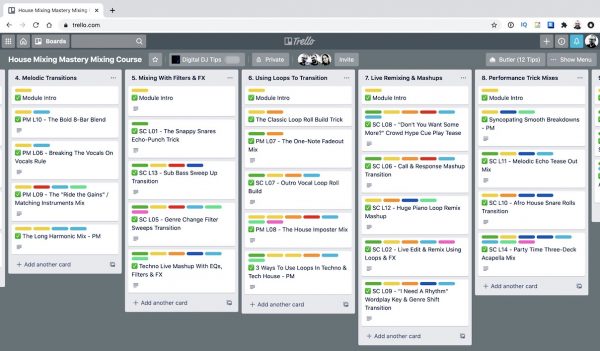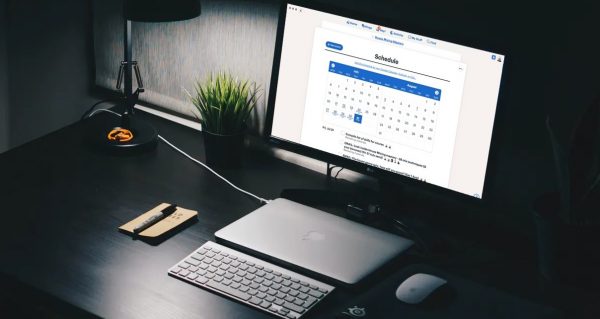We just released our new DJ course, “House Mixing Mastery”, to our members (it is fully released to the public next month). It’s been quite a ride, especially as from conception, to filming, to release, we’ve created the whole thing under quarantine.
I thought I’d share how we did it, and some of the things we learned. Whether to give you a little hope that however strange these times, good can come out of them, or just if you’re interested in how things work “behind the scenes” here at Digital DJ Tips, I hope you enjoy learning about this.
How we did it
1. We leveraged our existing online tools to the max

We are already a “distributed workforce” company – the management team is at our HQ in Gibraltar, production and customer support is in the UK, social media is run from the USA, and finance and operations are in Europe. That means we are used to working together, but remotely.
We never did have a central HQ where everyone “goes to work” – this was one of the things we wanted to avoid when we started the company back in 2010. We’ve always believed that talent is everywhere, so why limit who works with us to who is within reach of our Gibraltar HQ, lovely though it is (we’re based in the World Trade Center)?
By leaning heavily on our existing project management software, Basecamp (which is the “beating heart” of our company), cloud services (we use G Suite for planning spreadsheets, collaborative documents, email, and sharing music and videos), and of course by having regular remote meetings (we use Skype for one-to-ones, and Zoom for group meetings), we stayed organised and everyone remains in the loop.
On big projects like this, we often open a remote meeting, and simply have it running all day as we work – it feels after a while like working in the same room as your colleagues, as you can just chat when you need to. Great when working on the same topic.
2. We storyboarded the course “in the cloud”
Usually when we have “big” work to do, we rent a meeting room in a nice hotel or a business centre for a few days, assemble the team, and brainstorm. Great ideas come out of the frisson – it’s exhausting, but fun.
We do this regularly with the leadership team anyway, and occasionally with more of us, somewhere cool like LA or London. But we haven’t been able to have any such in-person planning meetings this year at all!
So for this course, we used a great online planing tool called Trello. It’s an implementation of something called “Kanban”, a planning discipline we’ve used for years anyway, and you can think of it as virtual “Post-It” notes. Each one contains something to be done, but being in the cloud, you can “open” the notes and add files, videos, to-do lists, collaborators, tags and so on.

When using this tool to plan a course, each “card” is a lesson – cards contain the lesson titles, what is to be in them, their video links and so on. We can then divide them into modules, to visually represent the journey a student will take when they buy the course. It’s a way to visualise the finished product and rearrange its elements till it “works” as a body of work. It helps us to make sure everything feels coherent and complete even before we’ve started filming anything.
3. We planned deliverables into a calendar
In the past, we’ve booked whole days out in one of our studios (we have two main studios for filming) and got together in one place. We’ve played music, tested ideas, and then (usually at about 4pm in the afternoon after a day of “being creative”), we hit on something gold – something we want to teach that we know students will love. From there on it’s a rush to get it filmed. Next day, we turn up, edit it, get creative again, repeat the process.
This time, though, we had to do it all apart. The main course tutors for House Mixing Mastery are Steve Canueto and myself, and we were both in separate recording studios. So we set micro deliverables – this video by this date, that lesson by that date. And then our production team made sure nobody was slipping.

We were worried that it would stifle creativity, but it turned out that the opposite was true – being forced to produce something by a set day meant that you found yourself planning it naturally in your head a day or two earlier, or thinking about it over the weekend, or suddenly coming up with the tunes you wanted to use in bed at midnight the night before filming, and rushing to write them down!
It was a different way of working, and a little less “freestyle”, but it definitely worked.
4. We filmed and edited our own work
This was one of the hardest things for me, personally. In the past we’ve spread the workload with a video editor to help us, but the problem we’ve found with creating teaching is that only we know, as the teachers, what needs to be on screen to help the students the best at any given time.
Annotations, beat counters, overhead shots, “talking head” shots, software screenshots, graphics – the right mix means students will “get it”, the wrong mix means the training will just be confusing.

The trouble is, that if the video editor isn’t there doing the filming, you can’t talk to them and explain what you want in the edited video, and why you want it – so instead, you end up going backwards and forward so much as they submit work that isn’t what you want, it would have been easier to do it yourself.
So as we were stuck “solo” in our studios, we decided we would film and edit our own work. It is painstaking, and time consuming, but you get into a flow in the end, and the result is that the teaching is exactly how you imagined it.
What you lose, though, is perspective, which is why the next point was so crucial.
5. We spread quality control across the team
So as this course had to be made in two separate places, we didn’t have the luxury of working together and “playing out of the same record crate” so to speak. There was always the danger that there would be accidental repetition of skills or techniques, or one of us would mention something in a lesson that would end up not being made, or – frankly – that a lesson would just not be very good, or not get its point across properly.
We’ve learned over the years that collaboration rules, and that there are many potential pitfalls when tasks are divided and people are left/trusted to get on with it.
So having done our best to work together to develop the teaching points we wanted to hit with this course upfront, and then gone away to film material “solo”, we engaged our production team to pick through each lesson afterwards, independently from us.
They were looking not only for technical errors, but also those annoying continuity issues that can happen from time to time – breaks in the course narrative. It is important always for us that our courses hold together as a “whole”, and the production team’s feedback was key to ensure that this course appeared like we had made it together, in the same place.
6. We replaced jam sessions with livestreams
This was one of the unexpected plusses of the whole thing. Usually as I mentioned above, we’ll book some studio time, bring a pile of tunes, and just jam. Ideas come out of DJing together, and those ideas turn into courses.
But we could do none of that this time. Where were the ideas going to come from? How could we swap and share thoughts on what we were thinking about, musically?
So we decided to do our practising for this course in public, by each taking turns to do a weekend livestream across the Digital DJ Tips channels. For instance, here is a Todd Terry tribute house mix that Steve did while we were making the course:
https://youtu.be/Z8R9-dYEwLo?rel=0
Little did we know how much this would help! The discipline of finding music, planning sets, and practising mixes and transitions was just what we needed to get that side of our minds working and ready to make the training. There was a feeling of friendly competitiveness, and we made sure we (and the company) listened to the weekly mixes and gave feedback.
Read this next: The Ultimate Guide To Mixing House Music
Many of those transitions from our livestreams gave us ideas for things to teach in the course – and we gained hundreds of thousands of listens, watches and follows too, many we’d imagine from people who hadn’t known about the school beforehand.
(Oh, and we got a livestreaming course made thanks to everything we learned, too – but that story is for another day!)
7. We shared what we were doing with our community
Across our StudentHub student-only Facebook Group and Global DJ Network public Facebook Group, we let people know what we were up to and how it was going. We’ve sometimes in the past liked to work quietly in the background on new projects, dropping them on the world when we’re ready, but it felt better this time – probably as a counter to the general mood and feeling of isolation – to share our progress a bit more publicly.
We benefited not only from the encouragement, but from some great ideas that were community-driven. In the end it made the job easier to complete, and we think the course is all the better for the community input.
Finally…
The past few months have not been easy, and we’ve had some difficult decisions to make, not least about team size in face of the recession the world is now in. We’ve also had some (at times) essential heart-to hearts – we all know tempers can fray under stress, and these times are nothing if not stressful.
What’s more, for the first half of 2020, we were meant to be working overseas with some big-name DJ/producers on projects that simply had to be shelved, as we couldn’t leave our homes, let alone our countries! So it wasn’t as if we just decided to make our new house mixing course for fun – we did it because it was about the only thing left in our plan for 2020 we still had half a chance of achieving under quarantine…
In all honesty, we just feel lucky we have been able to carry on working at all. So if you’re a DJ who is struggling, with a lack of gigs, or worse, we hope this story of what we’ve managed to achieve under a quarantine has in some way inspired or helped you.
And the course? Well, now it’s finished and on release to our members, feedback has been amazing. The best thing for us is that, apart from the fact that Steve and myself never appear in the same camera shot, we think it is indistinguishable from courses we’ve made previously under very different circumstances.
Better than that: Actually we think it’s the best course we’ve ever made.
Get the course: House Mixing Mastery





![Grimes's DJ mess-up - Lessons for us all? [Live Q&A] Grimes's DJ mess-up - Lessons for us all? [Live Q&A]](https://cdn.digitaldjtips.com/app/uploads/2024/04/19032806/18april-WEBSITE-150x150.jpg)
![Modular DJ Gear, Best Production DAW, Keeping Crowds Interested [Live Q&A] Modular DJ Gear, Best Production DAW, Keeping Crowds Interested [Live Q&A]](https://cdn.digitaldjtips.com/app/uploads/2024/03/07184219/7march-WEBSITE-150x150.jpg)

